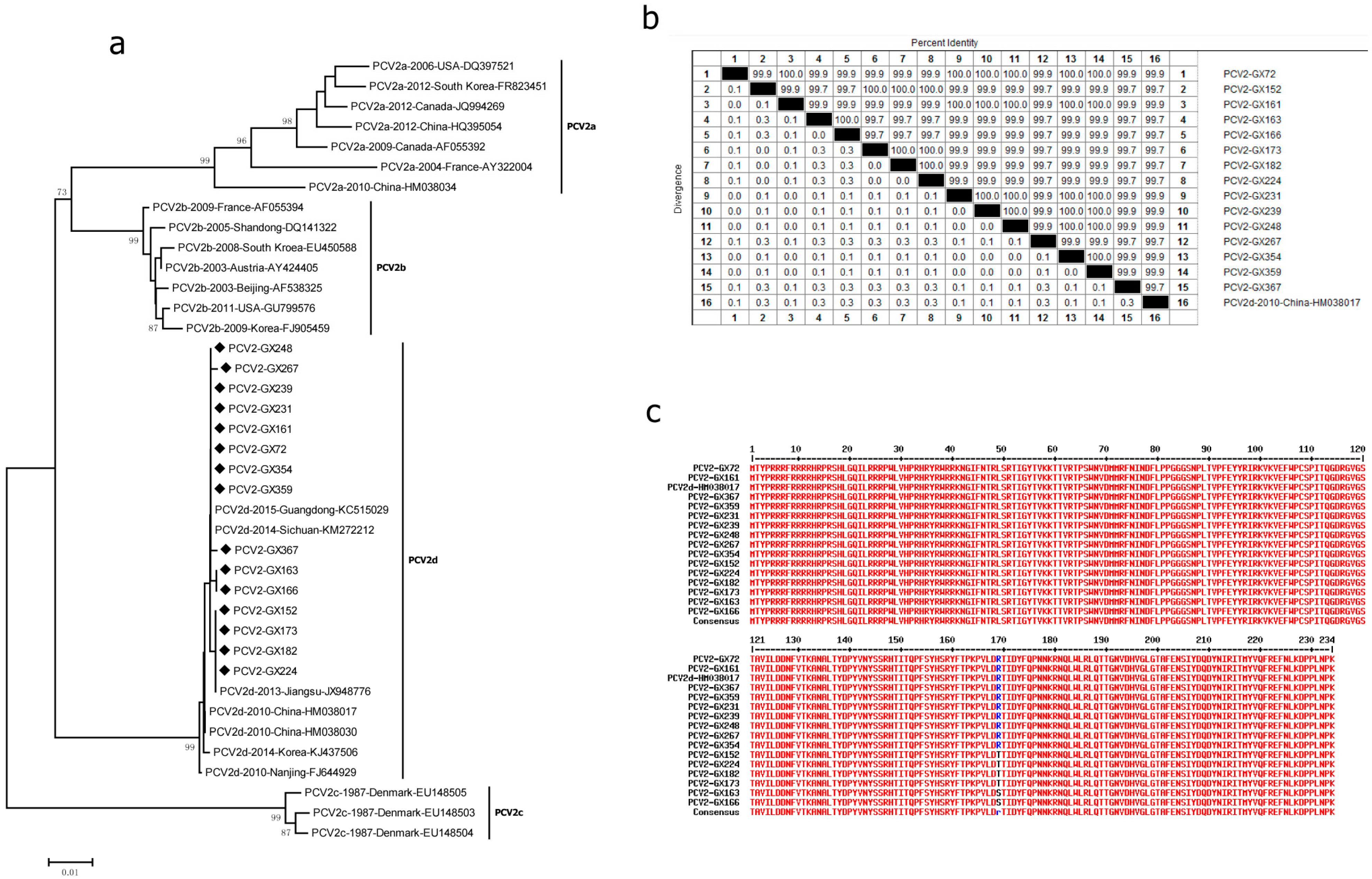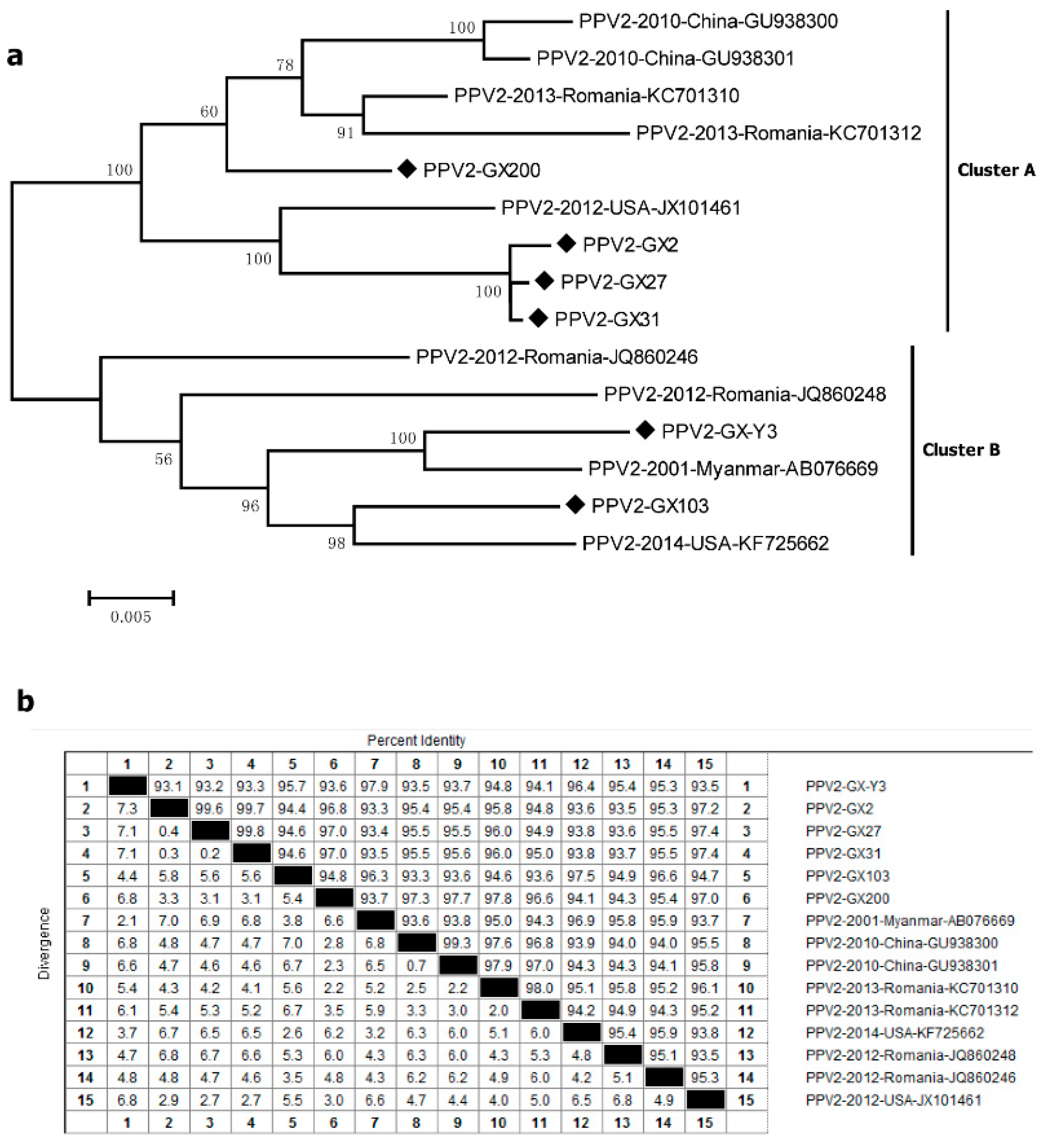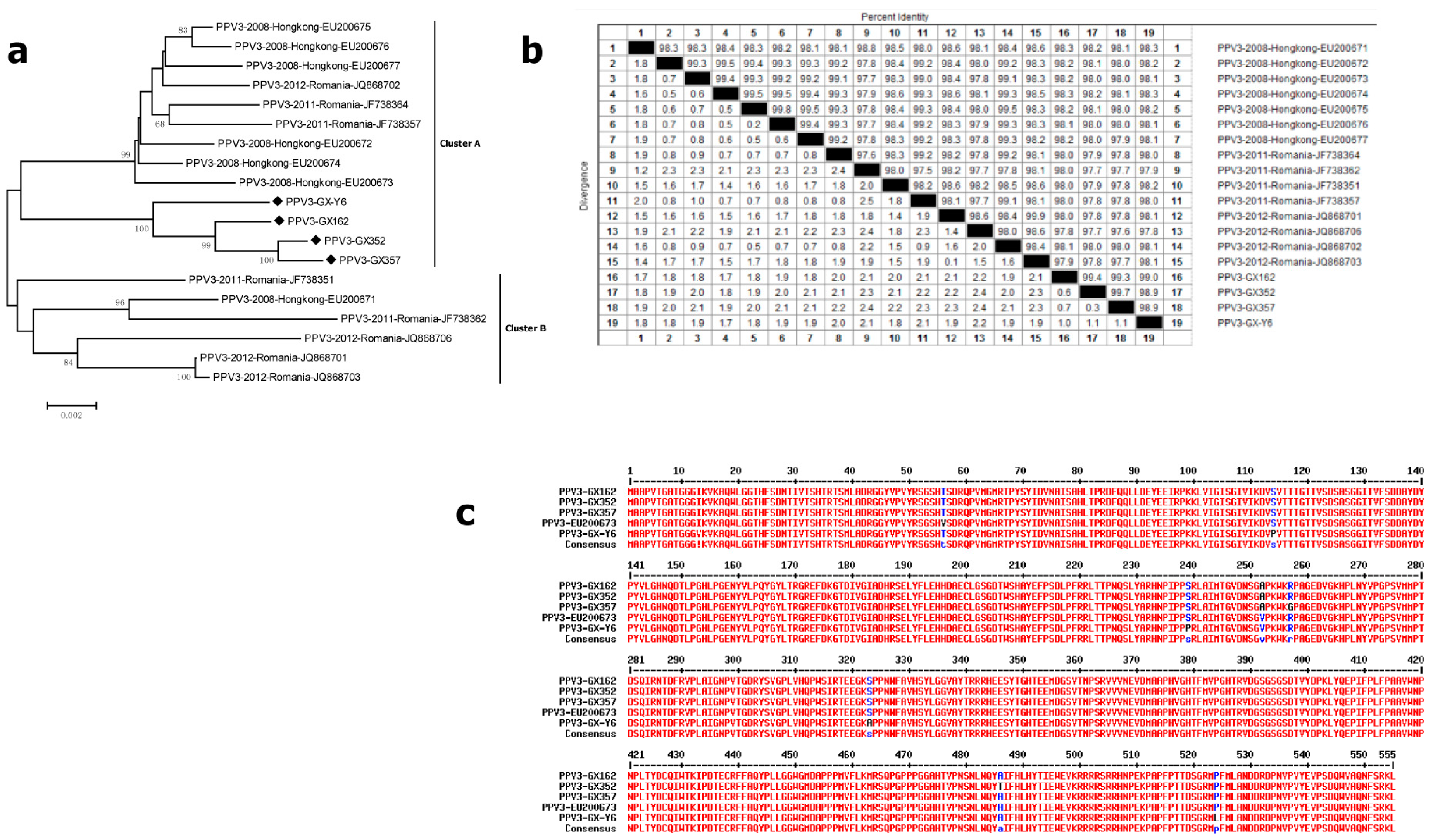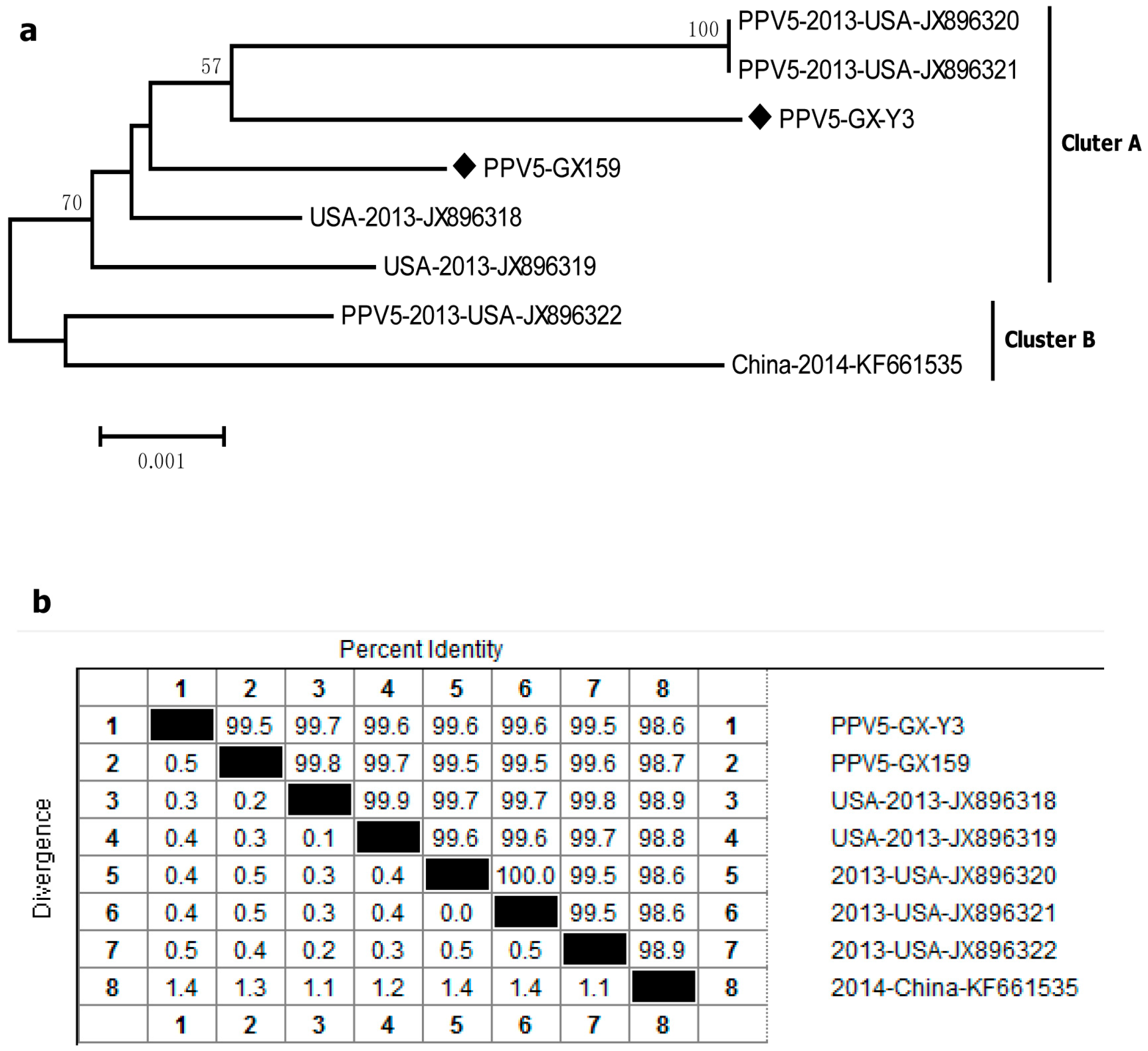Molecular Epidemiology of Porcine Circovirus Type 2 and Porcine Parvoviruses in Guangxi Autonomous Region, China
Abstract
1. Introduction
2. Materials and Methods
2.1. Collection of Samples
2.2. DNA Extraction
2.3. Detection of PCV2 and PPVs in Various Samples Using PCR
2.4. Sequencing and Phylogenetic Analyses
3. Results
3.1. Prevalence of PCV2 and PPVs on the Tissue Level
3.2. Prevalence of PCV2 and PPVs on the Individual Pig Level
3.3. Prevalence Rates of Double Infection on the Individual Pig Level
3.4. Genetic Diversity of PCV2 and Novel PPVs
3.4.1. PCV2
3.4.2. PPV2
3.4.3. PPV3
3.4.4. PPV5
4. Discussion
5. Conclusions
Author Contributions
Funding
Institutional Review Board Statement
Informed Consent Statement
Data Availability Statement
Acknowledgments
Conflicts of Interest
References
- Ellis, J.; Krakowka, S.; Lairmore, M.; Haines, D.; Bratanich, A.; Clark, E.; Allan, G.; Konoby, C.; Hassard, L.; Meehan, B.; et al. Reproduction of lesions of postweaning multisystemic wasting syndrome in gnotobiotic piglets. J. Vet. Diagn. Investig. 1999, 11, 3–14. [Google Scholar] [CrossRef] [PubMed]
- Ellis, J.A.; Bratanich, A.; Clark, E.G.; Allan, G.; Meehan, B.; Haines, D.M.; Harding, J.; West, K.H.; Krakowka, S.; Konoby, C.; et al. Coinfection by porcine circoviruses and porcine parvovirus in pigs with naturally acquired postweaning multisystemic wasting syndrome. J. Vet. Diagn. Investig. 2000, 12, 21–27. [Google Scholar] [CrossRef] [PubMed]
- Krakowka, S.; Ellis, J.A.; Meehan, B.; Kennedy, S.; McNeilly, F.; Allan, G. Viral wasting syndrome of swine: Experimental reproduction of postweaning multisystemic wasting syndrome in gnotobiotic swine by coinfection with porcine circovirus 2 and porcine parvovirus. Vet. Pathol. 2000, 37, 254–263. [Google Scholar] [CrossRef] [PubMed]
- Cheung, A.K.; Wu, G.; Wang, D.; Bayles, D.O.; Lager, K.M.; Vincent, A.L. Identification and molecular cloning of a novel porcine parvovirus. Arch. Virol. 2010, 155, 801–806. [Google Scholar] [CrossRef]
- Opriessnig, T.; Xiao, C.T.; Gerber, P.F.; Halbur, P.G. Emergence of a novel mutant PCV2b variant associated with clinical PCVAD in two vaccinated pig farms in the U.S. concurrently infected with PPV2. Vet. Microbiol. 2013, 163, 177–183. [Google Scholar] [CrossRef]
- Wang, F.; Wei, Y.; Zhu, C.; Huang, X.; Xu, Y.; Yu, L.; Yu, X. Novel parvovirus sublineage in the family of Parvoviridae. Virus Genes 2010, 41, 305–308. [Google Scholar] [CrossRef]
- Opriessnig, T.; Xiao, C.T.; Gerber, P.F.; Halbur, P.G. Identification of recently described porcine parvoviruses in archived North American samples from 1996 and association with porcine circovirus associated disease. Vet. Microbiol. 2014, 173, 9–16. [Google Scholar] [CrossRef]
- Sun, J.; Huang, L.; Wei, Y.; Wang, Y.; Chen, D.; Du, W.; Wu, H.; Liu, C. Prevalence of emerging porcine parvoviruses and their co-infections with porcine circovirus type 2 in China. Arch. Virol. 2015, 160, 1339–1344. [Google Scholar] [CrossRef]
- Kim, S.C.; Kim, J.H.; Kim, J.Y.; Park, G.S.; Jeong, C.G.; Kim, W.I. Prevalence of porcine parvovirus 1 through 7 (PPV1-PPV7) and co-factor association with PCV2 and PRRSV in Korea. BMC Vet. Res. 2022, 18, 133. [Google Scholar] [CrossRef]
- Allan, G.M.; Ellis, J.A. Porcine circoviruses: A review. J. Vet. Diagn. Investig. 2000, 12, 3–14. [Google Scholar] [CrossRef]
- Mankertz, A.; Caliskan, R.; Hattermann, K.; Hillenbrand, B.; Kurzendoerfer, P.; Mueller, B.; Schmitt, C.; Steinfeldt, T.; Finsterbusch, T. Molecular biology of Porcine circovirus: Analyses of gene expression and viral replication. Vet. Microbiol. 2004, 98, 81–88. [Google Scholar] [CrossRef]
- Tischer, I.; Rasch, R.; Tochtermann, G. Characterization of papovavirus-and picornavirus-like particles in permanent pig kidney cell lines. Zent. Bakteriol. Orig. A 1974, 226, 153–167. [Google Scholar]
- Tischer, I.; Gelderblom, H.; Vettermann, W.; Koch, M.A. A very small porcine virus with circular single-stranded DNA. Nature 1982, 295, 64–66. [Google Scholar] [CrossRef] [PubMed]
- Nainys, J.; Lasickiene, R.; Petraityte-Burneikiene, R.; Dabrisius, J.; Lelesius, R.; Sereika, V.; Zvirbliene, A.; Sasnauskas, K.; Gedvilaite, A. Generation in yeast of recombinant virus-like particles of porcine circovirus type 2 capsid protein and their use for a serologic assay and development of monoclonal antibodies. BMC Biotechnol. 2014, 14, 100. [Google Scholar] [CrossRef] [PubMed][Green Version]
- Zhang, H.; Qian, P.; Peng, B.; Shi, L.; Chen, H.; Li, X. A novel subunit vaccine co-expressing GM-CSF and PCV2b Cap protein enhances protective immunity against porcine circovirus type 2 in piglets. Vaccine 2015, 33, 2449–2456. [Google Scholar] [CrossRef]
- Zhang, H.H.; Hu, W.Q.; Li, J.Y.; Liu, T.N.; Zhou, J.Y.; Opriessnig, T.; Xiao, C.T. Novel circovirus species identified in farmed pigs designated as Porcine circovirus 4, Hunan province, China. Transbound. Emerg. Dis. 2020, 67, 1057–1061. [Google Scholar] [CrossRef]
- Turlewicz-Podbielska, H.; Augustyniak, A.; Pomorska-Mol, M. Novel Porcine Circoviruses in View of Lessons Learned from Porcine Circovirus Type 2-Epidemiology and Threat to Pigs and Other Species. Viruses 2022, 14, 261. [Google Scholar] [CrossRef]
- Cartwright, S.; Huck, R. Viruses isolated in association with herd infertility absortions and stillbirths in pigs. Vet. Rec. 1967, 81, 196. [Google Scholar]
- Mengeling, W.L.; Lager, K.M.; Vorwald, A.C. The effect of porcine parvovirus and porcine reproductive and respiratory syndrome virus on porcine reproductive performance. Anim. Reprod. Sci. 2000, 60–61, 199–210. [Google Scholar] [CrossRef]
- Hijikata, M.; Abe, K.; Win, K.M.; Shimizu, Y.K.; Keicho, N.; Yoshikura, H. Identification of new parvovirus DNA sequence in swine sera from Myanmar. Jpn. J. Infect. Dis. 2001, 54, 244–245. [Google Scholar]
- Csagola, A.; Lorincz, M.; Cadar, D.; Tombacz, K.; Biksi, I.; Tuboly, T. Detection, prevalence and analysis of emerging porcine parvovirus infections. Arch. Virol. 2012, 157, 1003–1010. [Google Scholar] [CrossRef] [PubMed]
- Lau, S.; Woo, P.; Tse, H.; Fu, C.; Au, W.K.; Chen, X.C.; Tsoi, H.W.; Tsang, T.; Chan, J.; Tsang, D.; et al. Identification of novel porcine and bovine parvoviruses closely related to human parvovirus 4. J. Gen. Virol. 2008, 89, 1840–1848. [Google Scholar] [CrossRef] [PubMed]
- Huang, L.; Zhai, S.L.; Cheung, A.K.; Zhang, H.B.; Long, J.X.; Yuan, S.S. Detection of a novel porcine parvovirus, PPV4, in Chinese swine herds. Virol. J. 2010, 7, 333. [Google Scholar] [CrossRef] [PubMed]
- Cheung, A.K.; Lager, K.M.; Kohutyuk, O.I.; Vincent, A.L.; Henry, S.C.; Baker, R.B.; Rowland, R.R.; Dunham, A.G. Detection of two porcine circovirus type 2 genotypic groups in United States swine herds. Arch. Virol. 2007, 152, 1035–1044. [Google Scholar] [CrossRef] [PubMed]
- Xiao, C.T.; Halbur, P.G.; Opriessnig, T. Complete Genome Sequence of a Novel Porcine Parvovirus (PPV) Provisionally Designated PPV5. Genome Announc. 2013, 1, 10–1128. [Google Scholar] [CrossRef]
- Ni, J.; Qiao, C.; Han, X.; Han, T.; Kang, W.; Zi, Z.; Cao, Z.; Zhai, X.; Cai, X. Identification and genomic characterization of a novel porcine parvovirus (PPV6) in China. Virol. J. 2014, 11, 203. [Google Scholar] [CrossRef]
- Li, J.; Xiao, Y.; Qiu, M.; Li, X.; Li, S.; Lin, H.; Li, X.; Zhu, J.; Chen, N. A Systematic Investigation Unveils High Coinfection Status of Porcine Parvovirus Types 1 through 7 in China from 2016 to 2020. Microbiol. Spectr. 2021, 9, e129421. [Google Scholar] [CrossRef]
- Cui, J.; Fan, J.; Gerber, P.F.; Biernacka, K.; Stadejek, T.; Xiao, C.T.; Opriessnig, T. First identification of porcine parvovirus 6 in Poland. Virus Genes 2017, 53, 100–104. [Google Scholar] [CrossRef][Green Version]
- Xing, X.; Zhou, H.; Tong, L.; Chen, Y.; Sun, Y.; Wang, H.; Zhang, G. First identification of porcine parvovirus 7 in China. Arch. Virol. 2018, 163, 209–213. [Google Scholar] [CrossRef]
- Streck, A.F.; Canal, C.W.; Truyen, U. Molecular epidemiology and evolution of porcine parvoviruses. Infect. Genet. Evol. 2015, 36, 300–306. [Google Scholar] [CrossRef]
- Streck, A.F.; Truyen, U. Porcine Parvovirus. Curr. Issues Mol. Biol. 2020, 37, 33–46. [Google Scholar] [CrossRef] [PubMed]
- Ssemadaali, M.A.; Ilha, M.; Ramamoorthy, S. Genetic diversity of porcine circovirus type 2 and implications for detection and control. Res. Vet. Sci. 2015, 103, 179–186. [Google Scholar] [CrossRef] [PubMed]
- Zhao, J.L.; Chen, H.C.; Lu, J.Q.; Qiu, D.X.; Zhou, F.C. Development of PCR Technique for Detecting Porcine Parvovirus Infection. China J. Vet. Sci. 2003, 23, 142–144. [Google Scholar]
- Burgara-Estrella, A.; Montalvo-Corral, M.; Bolanos, A.; Ramirez-Mendoza, H.; Valenzuela, O.; Hernandez, J. Naturally co-infected boars with both porcine reproductive and respiratory syndrome virus and porcine circovirus type 2. Transbound. Emerg. Dis. 2012, 59, 532–538. [Google Scholar] [CrossRef]
- Gerber, P.F.; Johnson, J.; Shen, H.; Striegel, D.; Xiao, C.T.; Halbur, P.G.; Opriessnig, T. Association of concurrent porcine circovirus (PCV) 2a and 2b infection with PCV associated disease in vaccinated pigs. Res. Vet. Sci. 2013, 95, 775–781. [Google Scholar] [CrossRef] [PubMed]
- Opriessnig, T.; Halbur, P.G. Concurrent infections are important for expression of porcine circovirus associated disease. Virus Res. 2012, 164, 20–32. [Google Scholar] [CrossRef] [PubMed]
- Park, C.; Seo, H.W.; Park, S.J.; Han, K.; Chae, C. Comparison of porcine circovirus type 2 (PCV2)-associated lesions produced by co-infection between two genotypes of PCV2 and two genotypes of porcine reproductive and respiratory syndrome virus. J. Gen. Virol. 2014, 95, 2486–2494. [Google Scholar] [CrossRef]
- Olvera, A.; Cortey, M.; Segales, J. Molecular evolution of porcine circovirus type 2 genomes: Phylogeny and clonality. Virology 2007, 357, 175–185. [Google Scholar] [CrossRef]
- Xiao, C.T.; Halbur, P.G.; Opriessnig, T. Global molecular genetic analysis of porcine circovirus type 2 (PCV2) sequences confirms the presence of four main PCV2 genotypes and reveals a rapid increase of PCV2d. J. Gen. Virol. 2015, 96, 1830–1841. [Google Scholar] [CrossRef]
- Zhai, S.L.; Chen, S.N.; Wei, Z.Z.; Zhang, J.W.; Huang, L.; Lin, T.; Yue, C.; Ran, D.L.; Yuan, S.S.; Wei, W.K.; et al. Co-existence of multiple strains of porcine circovirus type 2 in the same pig from China. Virol. J. 2011, 8, 517. [Google Scholar] [CrossRef]
- Davies, B.; Wang, X.; Dvorak, C.M.; Marthaler, D.; Murtaugh, M.P. Diagnostic phylogenetics reveals a new Porcine circovirus 2 cluster. Virus Res. 2016, 217, 32–37. [Google Scholar] [CrossRef] [PubMed]
- Franzo, G.; Cortey, M.; Olvera, A.; Novosel, D.; Castro, A.M.; Biagini, P.; Segales, J.; Drigo, M. Revisiting the taxonomical classification of Porcine Circovirus type 2 (PCV2): Still a real challenge. Virol. J. 2015, 12, 131. [Google Scholar] [CrossRef] [PubMed]
- Dupont, K.; Nielsen, E.O.; Bækbo, P.; Larsen, L.E. Genomic analysis of PCV2 isolates from Danish archives and a current PMWS case–control study supports a shift in genotypes with time. Vet. Microbiol. 2008, 128, 56–64. [Google Scholar] [CrossRef] [PubMed]
- Guo, L.J.; Lu, Y.H.; Wei, Y.W.; Huang, L.P.; Liu, C.M. Porcine circovirus type 2 (PCV2): Genetic variation and newly emerging genotypes in China. Virol. J. 2010, 7, 273. [Google Scholar] [CrossRef] [PubMed]
- Seo, H.W.; Park, C.; Kang, I.; Choi, K.; Jeong, J.; Park, S.J.; Chae, C. Genetic and antigenic characterization of a newly emerging porcine circovirus type 2b mutant first isolated in cases of vaccine failure in Korea. Arch. Virol. 2014, 159, 3107–3111. [Google Scholar] [CrossRef] [PubMed]
- Xiao, C.T.; Halbur, P.G.; Opriessnig, T. Complete genome sequence of a novel porcine circovirus type 2b variant present in cases of vaccine failures in the United States. J. Virol. 2012, 86, 12469. [Google Scholar] [CrossRef] [PubMed]
- Li, L.; Yuan, W.; Guo, H.; Ma, Z.; Song, Q.; Wang, X.; Li, H. Prevalence and genetic variation of porcine circovirus type 2 in Hebei, China from 2004 to 2014. Gene 2016, 586, 222–227. [Google Scholar] [CrossRef] [PubMed]
- Zhai, S.L.; Chen, S.N.; Xu, Z.H.; Tang, M.H.; Wang, F.G.; Li, X.J.; Sun, B.B.; Deng, S.F.; Hu, J.; Lv, D.H.; et al. Porcine circovirus type 2 in China: An update on and insights to its prevalence and control. Virol. J. 2014, 11, 88. [Google Scholar] [CrossRef]
- Shen, H.G.; Halbur, P.G.; Opriessnig, T. Prevalence and phylogenetic analysis of the current porcine circovirus 2 genotypes after implementation of widespread vaccination programmes in the USA. J. Gen. Virol. 2012, 93, 1345–1355. [Google Scholar] [CrossRef]
- Cadar, D.; Csagola, A.; Kiss, T.; Tuboly, T. Capsid protein evolution and comparative phylogeny of novel porcine parvoviruses. Mol. Phylogenet Evol. 2013, 66, 243–253. [Google Scholar] [CrossRef]




| Primer Name | Primer Sequence (5’–3’) | Size of PCR Product (bp) |
|---|---|---|
| PCV2-DF a | ATGGCATCTTCAACACCCG | 326 |
| PCV2-DR a | GATTGTATGGCGGGAGGAGT | |
| PPV1-DF b | TGGTCTCCTTCTGTGGTAGG | 445 |
| PPV1-DR b | CAGAATCAGCAACCTCAC | |
| PPV2-DF c | TACCAGACAGGCGACAACAAT | 338 |
| PPV2-DR c | CAGGCATAGGAGGAATGAAGG | |
| PPV3-DF d | GCAGTCTGCGCTTAACTT | 392 |
| PPV3-DR d | CTGCTTCATCCACTGGTC | |
| PPV4-DF e | GGAGACACAGTAGTTAGGACCCC | 406 |
| PPV4-DR e | TTTTCATACCCCAAATGGATAG | |
| PPV5-DF f | TGGTCACCGAGAACAGAAAG | 479 |
| PPV5-DR f | ATGCACCTGGTAAGGATGTC | |
| PCV2-AF g | ACTTACAGCGCACTTCTTTC | 771 |
| PCV2-AR g | GAGTCTTTTTTATCACTTCG | |
| PPV2-AF h | ATGAGCGCTGCCGACGCGTGGAAG | 3099 |
| PPV2-AR h | TTATACACGATGAGCGCGTCCCTCTGG | |
| PPV3-AF i | ATGGCTGCGCCGGTAACG | 1668 |
| PPV3-AR i | TTACAATTTGCGGGAGAAATTC | |
| PPV5-AF j | ATGAGCTTTAGTGGGTATTC | 2976 |
| PPV5-AR j | TTATCTTCTCGCTCTAACAC |
| Age | Tissue | PCV2 | PPV1 | PPV2 | PPV3 | PPV4 | PPV5 |
|---|---|---|---|---|---|---|---|
| Sow | Cord blood | 22/50 | 0/50 | 0/50 | 0/50 | 0/50 | 0/50 |
| Tonsil | 46/60 | 16/60 | 24/60 | 25/60 | 0/60 | 27/60 | |
| Pig from 15 to 112 days | Tonsil | 31/82 | 2/82 | 23/82 | 8/82 | 2/82 | 2/82 |
| Lung | 35/82 | 6/82 | 20/82 | 14/82 | 0/82 | 5/82 | |
| Mesenteric lymph node | 39/82 | 5/82 | 15/82 | 11/82 | 6/82 | 4/82 | |
| Hilar lymph node | 38/82 | 5/82 | 19/82 | 9/82 | 2/82 | 2/82 | |
| Superficial inguinal lymph node | 36/82 | 6/82 | 14/82 | 10/82 | 5/82 | 3/82 | |
| Total | 247/520 | 40/520 | 115/520 | 77/520 | 15/520 | 43/520 | |
| Age (Days) | PCV2 | PPV1 | PPV2 | PPV3 | PPV4 | PPV5 |
|---|---|---|---|---|---|---|
| 15–21 | 3/3 | 1/3 | 0/3 | 0/3 | 0/3 | 0/3 |
| 22–28 | 3/5 | 0/5 | 3/5 | 2/5 | 1/5 | 1/5 |
| 29–35 | 0/6 | 0/6 | 1/6 | 0/6 | 1/6 | 1/6 |
| 36–42 | 0/6 | 0/6 | 1/6 | 0/6 | 0/6 | 0/6 |
| 43–49 | 3/8 | 4/8 | 3/8 | 1/8 | 0/8 | 0/8 |
| 50–56 | 5/8 | 1/8 | 2/8 | 0/8 | 0/8 | 1/8 |
| 57–63 | 5/11 | 0/11 | 5/11 | 1/11 | 3/11 | 3/11 |
| 64–70 | 3/7 | 2/7 | 5/7 | 3/7 | 0/7 | 1/7 |
| 71–77 | 2/6 | 2/6 | 3/6 | 0/6 | 0/6 | 0/6 |
| 78–84 | 2/5 | 1/5 | 2/5 | 1/5 | 0/5 | 1/5 |
| 85–91 | 4/4 | 0/4 | 2/4 | 2/4 | 1/4 | 0/5 |
| 92–98 | 5/6 | 0/6 | 1/6 | 1/6 | 2/6 | 1/6 |
| 99–105 | 5/5 | 2/5 | 1/5 | 3/5 | 2/5 | 0/5 |
| 106–112 | 2/2 | 0/2 | 1/2 | 2/2 | 2/2 | 0/2 |
| Total | 42/82 | 13/82 | 30/82 | 16/82 | 12/82 | 9/82 |
| Double Infection | Number of Pigs | C2 Value | p-Value | ||||
|---|---|---|---|---|---|---|---|
| +/+ | +/− | −/+ | −/− | ||||
| PCV2 | PPV1 | 7 | 35 | 6 | 34 | 0.043 | 0.836 |
| PPV2 | 21 | 21 | 9 | 31 | 6.678 | 0.01 * | |
| PPV3 | 14 | 28 | 2 | 38 | 10.473 | 0.001 * | |
| PPV4 | 11 | 31 | 1 | 39 | 9.204 | 0.002 * | |
| PPV5 | 3 | 39 | 6 | 34 | 1.294 | 0.255 | |
| PPV1 | PPV2 | 9 | 4 | 21 | 48 | 5.523 | 0.019 * |
| PPV3 | 1 | 12 | 15 | 54 | 0.625 | 0.429 | |
| PPV4 | 0 | 13 | 12 | 57 | 1.439 | 0.230 | |
| PPV5 | 3 | 10 | 6 | 63 | 1.078 | 0.299 | |
| PPV2 | PPV3 | 7 | 23 | 9 | 43 | 0.440 | 0.507 |
| PPV4 | 4 | 26 | 8 | 44 | 0.000 | 1.000 | |
| PPV5 | 6 | 24 | 3 | 49 | 2.621 | 0.105 | |
| PPV3 | PPV4 | 4 | 12 | 8 | 58 | 0.834 | 0.361 |
| PPV5 | 1 | 15 | 8 | 58 | 0.052 | 0.819 | |
| PPV4 | PPV5 | 1 | 11 | 8 | 62 | 0.000 | 1.000 |
Disclaimer/Publisher’s Note: The statements, opinions and data contained in all publications are solely those of the individual author(s) and contributor(s) and not of MDPI and/or the editor(s). MDPI and/or the editor(s) disclaim responsibility for any injury to people or property resulting from any ideas, methods, instructions or products referred to in the content. |
© 2023 by the authors. Licensee MDPI, Basel, Switzerland. This article is an open access article distributed under the terms and conditions of the Creative Commons Attribution (CC BY) license (https://creativecommons.org/licenses/by/4.0/).
Share and Cite
Chen, P.; Wang, G.; Chen, J.; Zhang, W.; He, Y.; Qian, P. Molecular Epidemiology of Porcine Circovirus Type 2 and Porcine Parvoviruses in Guangxi Autonomous Region, China. Microbiol. Res. 2023, 14, 1331-1342. https://doi.org/10.3390/microbiolres14030090
Chen P, Wang G, Chen J, Zhang W, He Y, Qian P. Molecular Epidemiology of Porcine Circovirus Type 2 and Porcine Parvoviruses in Guangxi Autonomous Region, China. Microbiology Research. 2023; 14(3):1331-1342. https://doi.org/10.3390/microbiolres14030090
Chicago/Turabian StyleChen, Pin, Geng Wang, Jiping Chen, Weichao Zhang, Yin He, and Ping Qian. 2023. "Molecular Epidemiology of Porcine Circovirus Type 2 and Porcine Parvoviruses in Guangxi Autonomous Region, China" Microbiology Research 14, no. 3: 1331-1342. https://doi.org/10.3390/microbiolres14030090
APA StyleChen, P., Wang, G., Chen, J., Zhang, W., He, Y., & Qian, P. (2023). Molecular Epidemiology of Porcine Circovirus Type 2 and Porcine Parvoviruses in Guangxi Autonomous Region, China. Microbiology Research, 14(3), 1331-1342. https://doi.org/10.3390/microbiolres14030090




